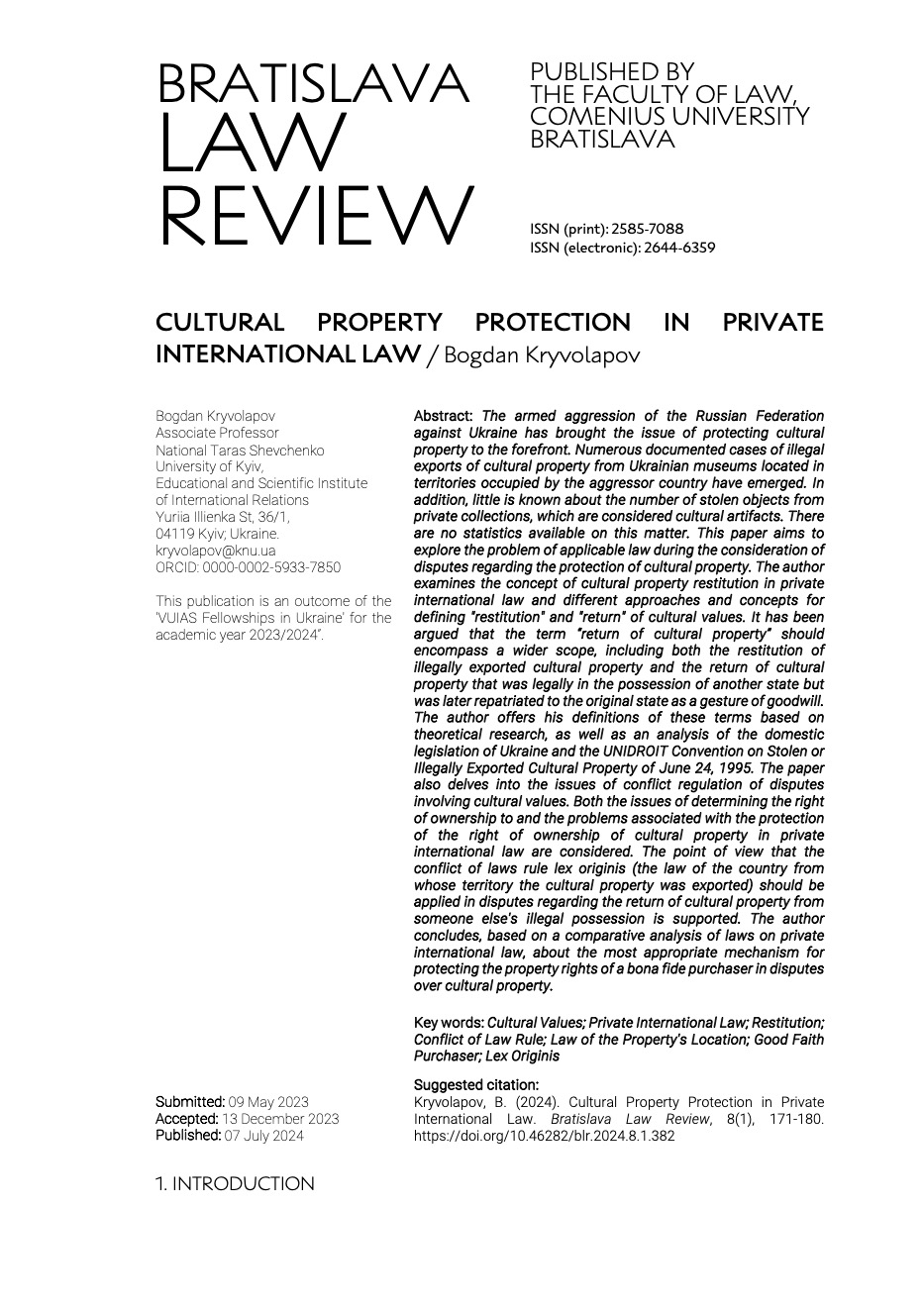Cultural Property Protection in Private International Law
DOI:
https://doi.org/10.46282/blr.2024.8.1.382Keywords:
Cultural Values, Private International Law, Restitution, Conflict of Law Rule, Law of the Property's Location, Good Faith Purchaser, Lex OriginisAbstract
The armed aggression of the Russian Federation against Ukraine has brought the issue of protecting cultural property to the forefront. Numerous documented cases of illegal exports of cultural property from Ukrainian museums located in territories occupied by the aggressor country have emerged. In addition, little is known about the number of stolen objects from private collections, which are considered cultural artifacts. There are no statistics available on this matter. This paper aims to explore the problem of applicable law during the consideration of disputes regarding the protection of cultural property. The author examines the concept of cultural property restitution in private international law and different approaches and concepts for defining "restitution" and "return" of cultural values. It has been argued that the term “return of cultural property” should encompass a wider scope, including both the restitution of illegally exported cultural property and the return of cultural property that was legally in the possession of another state but was later repatriated to the original state as a gesture of goodwill. The author offers his definitions of these terms based on theoretical research, as well as an analysis of the domestic legislation of Ukraine and the UNIDROIT Convention on Stolen or Illegally Exported Cultural Property of June 24, 1995. The paper also delves into the issues of conflict regulation of disputes involving cultural values. Both the issues of determining the right of ownership to and the problems associated with the protection of the right of ownership of cultural property in private international law are considered. The point of view that the conflict of laws rule lex originis (the law of the country from whose territory the cultural property was exported) should be applied in disputes regarding the return of cultural property from someone else's illegal possession is supported. The author concludes, based on a comparative analysis of laws on private international law, about the most appropriate mechanism for protecting the property rights of a bona fide purchaser in disputes over cultural property.
References
Akulenko, V. (2013a). Mizhnarodne pravo okhorony kulturnykh tsinnostei ta yoho implementatsiia u vnutrishnomu pravi Ukrainy [International law on the protection of cultural values and its implementation in the domestic law of Ukraine]. YuSTINIAN.
Akulenko, V. I. (2013b). “Terminy yak mezhi mizhnarodno-pravovykh poniat “restytutsiia” i «restytutsiia kulturnykh tsinnostei” [Terms as the confines of international legal concepts of “restitutio”» and “restitution of cultural treasures”]. Pratsi Tsentru pamiatkoznavsta, (24), 284–295.
Barsukova, O. (2022). Rosiiany taky vkraly skifske zoloto – Ofis henprokurora [The Russians did steal Scythian gold - Prosecutor General's Office]. Ukrainska Pravda, published on 10 May 2022. Available at: https://life.pravda.com.ua/culture/2022/05/10/248597/ (accessed on 16.04.2024).
Chechi, A. (2018). When private international law meets cultural heritage law - problems and prospects. Yearbook of Private International Law, Vol. XIX - 2017/2018, 269–294, https://doi.org/10.9785/9783504386078-014
Dudenko, T. (2017). Tsyvilno-pravova okhorona prav na kulturni tsinnosti ta yikh oborozdatnist [Civil legal protection of cultural values rights and its turnover]. Dissertation. Available at: https://dspace.nlu.edu.ua/bitstream/123456789/15367/1/Dudenko_2017.pdf (accessed on 16.04.2024).
Fincham, D. (2009). How adopting the Lex originis rule can impede the flow of illicit cultural property. Columbia Journal of Law and the Arts, 32, 2008, 111–150. Available at: https://papers.ssrn.com/sol3/papers.cfm?abstract_id=1287365 (accessed on 16.04.2024).
Koval, D. (2016). V imia mystetstva: mizhnarodno-pravovyi kontekstualnyi analiz zakhystu kulturnykh tsinnostei u zviazku zi zbroinym konflikom [In the name of art: an international legal contextual analysis of the protection of cultural values in connection with armed conflict]. Feniks.
Lototska, N. (2022). Okupanty rozghrabuvaly Khersonskyi khudozhnii muzei: vynosyly vse, shcho bachyly [The occupiers ransacked the Kherson Art Museum: they took away everything they saw]. LB.ua, published on 5 November 2022. Available at: https://lb.ua/culture/2022/11/05/534949_okupanti_rozgrabuvali_hersonskiy.html (accessed on 28.03.2023).
Merryman, J. H. (2007). The good faith acquisition of stolen art. Stanford Public Law Working Paper No. 1025515, Stanford Law and Economics Olin Working Paper No. 364, https://doi.org/10.2139/ssrn.1025515.
Reyhan, P. Y. (2001). A chaotic palette: Conflict of laws in litigation between original owners and good-faith purchasers of stolen art. Duke Law Journal, 50(4), 955–1043, https://doi.org/10.2307/1373101.
Sauer, P. (2022). Ukraine accuses Russian forces of seizing 2,000 artworks in Mariupol. The Guardian, published on 29 April 2022. Available at: https://www.theguardian.com/world/2022/apr/29/ukraine-accuses-russian-forces-of-seizing-2000-artworks-in-mariupol (accessed on 28.03.2023).
Shuba, B. (2017). Zakhyst kulturnykh tsinnostei: Lex rei sitae vs. protydiia nezakonnomu obihu (mizhnarodnyi dosvid) [Protection of cultural values: Lex rei sitae vs. combating illegal trafficking (international experience)]. Akutalni problemy vidchyznianoi yuryspudentsii, 3, 215–218.
Symeonides, S. C. (2021). A choice-of-law rule for conflicts involving stolen cultural property, Vanderbilt Journal of Transnational Law, 38(4), 1177-1198. Available at: https://scholarship.law.vanderbilt.edu/vjtl/vol38/iss4/10/ (accessed on 16.04.2024).
Zeidler, K. (2016). Restitution of Cultural Property: Hard Case, Theory of Argumentation, Philosophy of Law. Gdańsk: Gdańsk University Press.
Kodeks na Mezhdunarotnoto chastno pravo ot 17 May 2005 g., No. 42. [Bulgarian Private International Code No. 42, May 4, 2005].
Law of 16 July 2004 holding the Code of Private International Law No. 2004009511.
Law of Ukraine on export, import and return of cultural values No. 1068-XIV
Law of Ukraine on private international law No. 2709-IV
UNIDROIT. (2022). States parties. UNIDROIT. Available at: https://www.unidroit.org/instruments/cultural-property/1995-convention/status/ (accessed on 13.04.2023).
The International Sale of Works of Art from the Angle of the Protection of the Cultural Heritage.
Unidroit Convention on stolen or illegally exported cultural objects.
Zakon o Međunarodnom Privatnom pravu. 23. decembra 2013, No. 01-1973/2 [International Private Law Act of Montenegro No. 01-1973/2, December 23, 2013].

Downloads
Published
License
Copyright (c) 2024 Bratislava Law Review

This work is licensed under a Creative Commons Attribution-NonCommercial-NoDerivatives 4.0 International License.
The Author(s) transfers copyright to the Article to the Publisher of the Journal by the Licence Agreement.
The Author(s) retains rights specified in the Licence Agreement.
The readers may read, download, copy, distribute, print, search, or link to the full texts of all of the Article of the Journal and use them for any other lawful purpose under specified Creative Commons Licence (CC BY-NC-ND 4.0).











